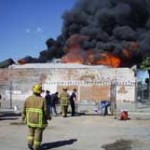Block and Brick Warehouse Construction Live Fire Testing
By Christopher J. Naum, SFPE on Dec 26, 2010 with Comments 0
Another series of experiments were conducted in Phoenix, Arizona using a brick and block warehouse structure with a “traditional” wood frame roof assembly. This set of two experiments included measurement of temperatures and carbon monoxide inside the structure. The building was approximately 150 feet long by 50 feet wide. Infra-red (IR) cameras were used on the outside of the building to evaluate their usefulness in structural collapse prediction by incident commanders. In addition, vibration sensors were attached to the structure to “listen” for signs of structural collapse.
A firewall was constructed to divide the warehouse into two fire compartments. Stacks of wood pallets were used as the primary fuel source and were ignited using paper and an electric match. Some combustible debris and the building structural elements provided the remainder of the fuel load. Each portion of the structure was allowed to burn until the roof was completely destroyed.
Peak temperatures obtained during the tests ranged from approximately 300 ºC (570 ºF) to 800 ºC (1470 ºF). Peak carbon monoxide measurement reached 4 % in the first test and 5 % during the second test. The roof of the front half of the structure burned through approximately 18 minutes after ignition of the fire. The roof of the back half of the structure began burning about 15 minutes after the start of the second test.
 Structural Collapse Fire Tests: Single Story, Ordinary Construction Warehouse (PDF, 8.0 Mb)
Structural Collapse Fire Tests: Single Story, Ordinary Construction Warehouse (PDF, 8.0 Mb)- A DVD, Structural Collapse Fire Tests, containing the reports and video clips of some of the fire experiments is available by contacting David W. Stroup of NIST at 301-975-6564 or david.stroup@nist.gov.
Filed Under: Anatomy of Buildings • Research • Research Hub • The Collapse Zone
























